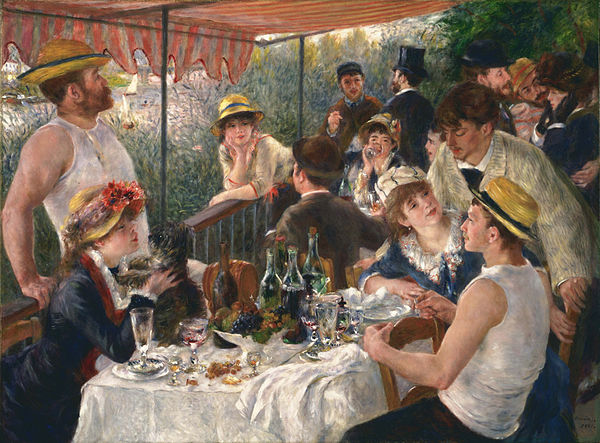Tokenhouse, ever the intellectual, describes the evolution of his painting style. “I began taking the bus over the bridge to Mestre, and attempting some plein air studies.” [TK 129/ 122] His plan to paint a hydroelectric plant was stymied when he was accused of industrial espionage.

Luncheon of the Boating Party
Pierre Auguste Renoir, 1880-81
oil on canvas, 51 x 69 in
The Phillips Collection, Washington, DC
photo in public domain from Wikimedia Commons via the Google Art Project
Painting outside, or as the French say en plein air, was not invented by or limited to the Impressionists, but they were plein air enthusiasts. We could show any number of Impressionist landscapes, especially the series, like those of Monet, that emphasize the constant fluidity of outdoor scenes. Renoir’s Luncheon of the Boating Party recalls the sociality of the Impressionists, who would gather to paint in the summer along the Seine outside Paris. Tokenhouse is a loner and much more interested in politics than in beauty. He says, “Much more important that the interfering attitudes of the authorities [who accused him of spying] was my own fear that Impressionist errors were creeping back, just as fallaciously as if I was one of the old ladies sitting on a camp-stool in front of the Salute.” [TK 129-130/122]

The Gardener Vallier Paul Cezanne c. 1906 oil on canvas, 26 x 22 in The Tate Liverpool shown here by Creative Commons CC-BY-NC-ND (3.0 Unported) permission
Tokenhouse describes his efforts to avoid Formalism. Jenkins cannot tell if a canvas is Formalist or Reformed: “This latest canvas, vermillion and light cobalt, showed origins of the fresco technique in representing what were evidently factory workers, stripped to the waist, pushing over a precipice a disordered groups of kings and bishops, easily recognizable by their crowns and mitres.” [TK 131/124] Formalism emphasizes color, techniques, and composition over content. The style of Cezanne, whose work is conducive to Formalist analysis, might not have caught the terror on the faces of the deposed that Tokenhouse showed.
Symbolism refers to work that emphasizes ideas rather than realistic depictions; figures are often icongraphic. The work of Gauguin is often cited as an example. Not all Symbolist work is political. Tokenhouse’s “wooden” figures were more symbolic than realistic, but he told Jenkins that he found “Politico-Symbolism, for a person of my imaginative faculties, a cul de sac.” [TK 131/124]